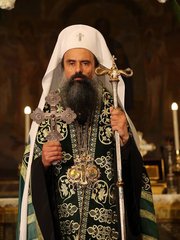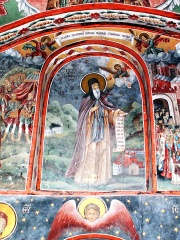
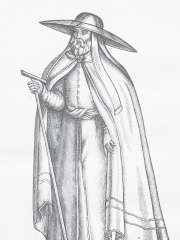
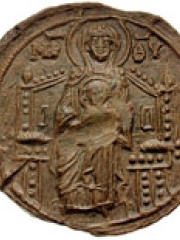
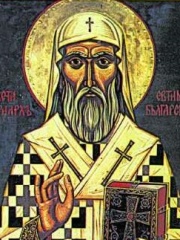
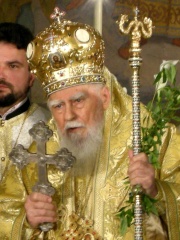
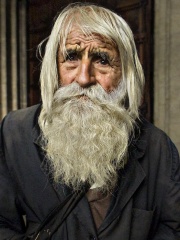

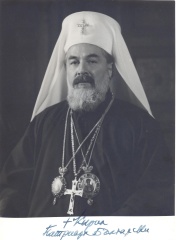
The Most Famous
RELIGIOUS FIGURES from Bulgaria
This page contains a list of the greatest Bulgarian Religious Figures. The pantheon dataset contains 3,187 Religious Figures, 11 of which were born in Bulgaria. This makes Bulgaria the birth place of the 39th most number of Religious Figures behind Argentina, and Romania.
Top 10
The following people are considered by Pantheon to be the top 10 most legendary Bulgarian Religious Figures of all time. This list of famous Bulgarian Religious Figures is sorted by HPI (Historical Popularity Index), a metric that aggregates information on a biography's online popularity. Visit the rankings page to view the entire list of Bulgarian Religious Figures.

1. John of Rila (876 - 946)
With an HPI of 68.63, John of Rila is the most famous Bulgarian Religious Figure. His biography has been translated into 24 different languages on wikipedia.
Saint John of Rila, also known as Ivan of Rila (Bulgarian: Свети преподобни Йоан Рилски Чудотворец, romanized: Sveti prepodobni Yoan Rilski Chudotvorets, lit. 'Saint John of Rila the Wondermaker'; c. 876 – 18 August 946), was the first Bulgarian hermit. He was revered as a saint while he was still alive. The legend surrounding him tells of wild animals that freely came up to him and birds that landed in his hands. His followers founded many churches in his honor, including the famous Rila Monastery. One of these churches, Saint John of Rila was only discovered in 2008 in the town of Veliko Tarnovo. Today, he is honored as the patron saint of the Bulgarians and as one of the most important saints in the Bulgarian Orthodox Church.

2. Jeremias II of Constantinople (1536 - 1595)
With an HPI of 67.01, Jeremias II of Constantinople is the 2nd most famous Bulgarian Religious Figure. His biography has been translated into 22 different languages.
Jeremias II of Constantinople (Greek: Ἰερεμίας Τρανός; c. 1530 – 4 September 1595) was Ecumenical Patriarch of Constantinople three times between 1572 and 1595.

3. John XIV of Constantinople (1282 - 1347)
With an HPI of 63.11, John XIV of Constantinople is the 3rd most famous Bulgarian Religious Figure. His biography has been translated into 17 different languages.
John XIV of Constantinople, surnamed Kalekas (Greek: Ἰωάννης Καλέκας; c. 1282 – 29 December 1347), was the Ecumenical Patriarch of Constantinople from 1334 to 1347. He was an anti-hesychast and opponent of Gregory Palamas. He was an active participant in the Byzantine civil war of 1341–1347 as a member of the regency for Emperor John V Palaiologos, against Emperor John VI Kantakouzenos.

4. Euthymius of Tarnovo (1317 - 1402)
With an HPI of 62.69, Euthymius of Tarnovo is the 4th most famous Bulgarian Religious Figure. His biography has been translated into 18 different languages.
Saint Euthymius of Tarnovo (also Evtimiy; Bulgarian: Свети Евтимий Търновски, Sveti Evtimiy Tarnovski) was Patriarch of Bulgaria between 1375 and 1393. Regarded as one of the most important figures of medieval Bulgaria, Euthymius was the last head of the Bulgarian Orthodox Church in the Second Bulgarian Empire. Arguably the best esteemed of all Bulgarian patriarchs, Euthymius was a supporter of hesychasm and an authoritative figure in the Eastern Orthodox world of the time.
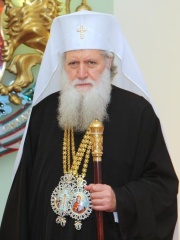
5. Neophyte of Bulgaria (1945 - 2024)
With an HPI of 62.21, Neophyte of Bulgaria is the 5th most famous Bulgarian Religious Figure. His biography has been translated into 23 different languages.
Patriarch Neophyte (Bulgarian: Патриарх Неофит, romanized: Patriarch Neofit; secular name: Simeon Nikolov Dimitrov; Bulgarian: Симеон Николов Димитров; 15 October 1945 – 13 March 2024) was the Patriarch of All Bulgaria, head of the Bulgarian Orthodox Church from 24 February 2013 until his death on 13 March 2024. Prior to his election, he was the Metropolitan Bishop of Ruse (2001–2013) and Bishop of Dorostol and Cherven (1994–2001).

6. Maxim of Bulgaria (1914 - 2012)
With an HPI of 60.84, Maxim of Bulgaria is the 6th most famous Bulgarian Religious Figure. His biography has been translated into 21 different languages.
Patriarch Maxim (Maximus) (Bulgarian: Патриарх Максим) (born Marin Naydenov Minkov, October 29, 1914 – November 6, 2012) was the head of the Bulgarian Orthodox Church from 1971 until his death. He was born in Oreshak, the second of the two children of Nayden Minkov Rachev and Pena Bordzhukova, but very little is known about his parents' background. He was educated only in his native mountain village of Oreshak but from his late childhood, he became a novice monk in the Troyan Monastery and then studied Orthodox Theology at Sofia University, from which he graduated in 1935 with honours. In 1942 he graduated from the Saint Clement of Ohrid State University of Sofia. He took Holy Orders in 1941 and became secretary general of the Holy Synod in 1955 and titular bishop of Branit on December 30, 1956. In 1960, he was elected Metropolitan of Lovech on October 30, 1960, and won the election as Patriarch on July 4, 1971, after Patriarch Kyril died. In the early 1990s, a split in the Bulgarian Church was stimulated by the government of the Union of Democratic Forces, based on the alleged cooperation and affiliation of Maxim with the former regime. However, Maxim was able to take control of the majority of the parishes and to prevent any schismatic threats within the Church. The faction against Maxim formed the Bulgarian Orthodox Church – Alternative synod.

7. Dobri Dobrev (1914 - 2018)
With an HPI of 58.78, Dobri Dobrev is the 7th most famous Bulgarian Religious Figure. His biography has been translated into 20 different languages.
Dobri Dimitrov Dobrev (Bulgarian: Добри Димитров Добрев, pronounced [ˈdɔbri dimiˈtrɔf ˈdɔbrɛf]; 20 July 1914 – 13 February 2018), better known as Grandpa Dobri, Elder Dobri (Bulgarian: Дядо Добри, romanized: Dyado Dobri) or The Saint of Bailovo, was a Bulgarian ascetic who walked over 20 kilometres (12 mi) each day to sit or stand in front of the Cathedral of Alexander Nevsky in Sofia to collect money for charitable causes. Dobrev donated all the money he collected to charities, orphanages, churches, and monasteries. He turned 100 in July 2014. In Bulgarian, his name translates as "good" or "kind".

8. Ivan II of Bulgaria (1300 - 1300)
With an HPI of 57.47, Ivan II of Bulgaria is the 8th most famous Bulgarian Religious Figure. His biography has been translated into 17 different languages.
Ivan II (Bulgarian: Иван II, or Йоан II, Ioan II, also styled inconsistently Ivan IV or Ioan IV), reigned as tsar of Bulgaria from 1298 to 1299. The date of his birth is unknown, but probably not much earlier than c. 1290. He died as a monk in exile before 1330.

9. Cyril of Bulgaria (1901 - 1971)
With an HPI of 56.63, Cyril of Bulgaria is the 9th most famous Bulgarian Religious Figure. His biography has been translated into 16 different languages.
Patriarch Cyril (Bulgarian: Патриарх Кирил; secular name Konstantin Markov Konstantinov [Bulgarian: Константин Марков Константинов]; January 3, 1901 – March 7, 1971) was the first Patriarch of the restored Bulgarian Patriarchate. Born in Sofia, Bulgaria, to a family of Aromanian descent, he adopted his religious name of Cyril in the St. Nedelya Church on December 30, 1923 and became Metropolitan of Plovdiv in 1938. On May 10, 1953 Cyril was elected Patriarch of Bulgaria, holding the position until his death. Cyril was buried in the main church of the Bachkovo Monastery, 189 kilometres from Sofia. Cyril's historical role in the Bulgarian popular resistance to the Holocaust is recounted in the oratorio A Melancholy Beauty, composed by Georgi Andreev with libretto by Scott Cairns and Aryeh Finklestein. The text describes "Metropolitan Kyril" in 1943 confronting the captors of Bulgarian Jews slated to be deported. Kyril first pledged to go with the deportees in solidarity and then told the guards he will block the train with his own body. The guards replied that they have just received new orders to release the Jews. For his work in saving Jews, Cyril, as well as Stefan I of Bulgaria, were recognized by Yad Vashem as the Righteous Among the Nations in 2001. Cyril was succeeded by Maxim of Bulgaria.
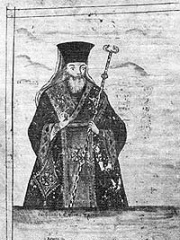
10. Sophronius of Vratsa (1739 - 1813)
With an HPI of 56.20, Sophronius of Vratsa is the 10th most famous Bulgarian Religious Figure. His biography has been translated into 15 different languages.
Saint Sophronius of Vratsa (or Sofroniy Vrachanski; Bulgarian: Софроний Врачански; 1739–1813), born Stoyko Vladislavov (Bulgarian: Стойко Владиславов), was a Bulgarian cleric and one of the leading figures of the early Bulgarian National Revival.
People
Pantheon has 11 people classified as Bulgarian religious figures born between 876 and 1972. Of these 11, 1 (9.09%) of them are still alive today. The most famous living Bulgarian religious figures include Daniil of Bulgaria. The most famous deceased Bulgarian religious figures include John of Rila, Jeremias II of Constantinople, and John XIV of Constantinople. As of April 2024, 1 new Bulgarian religious figures have been added to Pantheon including Daniil of Bulgaria.
Living Bulgarian Religious Figures
Go to all RankingsDeceased Bulgarian Religious Figures
Go to all RankingsJohn of Rila
876 - 946
HPI: 68.63
Jeremias II of Constantinople
1536 - 1595
HPI: 67.01
John XIV of Constantinople
1282 - 1347
HPI: 63.11
Euthymius of Tarnovo
1317 - 1402
HPI: 62.69
Neophyte of Bulgaria
1945 - 2024
HPI: 62.21
Maxim of Bulgaria
1914 - 2012
HPI: 60.84
Dobri Dobrev
1914 - 2018
HPI: 58.78
Ivan II of Bulgaria
1300 - 1300
HPI: 57.47
Cyril of Bulgaria
1901 - 1971
HPI: 56.63
Sophronius of Vratsa
1739 - 1813
HPI: 56.20
Newly Added Bulgarian Religious Figures (2025)
Go to all RankingsOverlapping Lives
Which Religious Figures were alive at the same time? This visualization shows the lifespans of the 4 most globally memorable Religious Figures since 1700.

